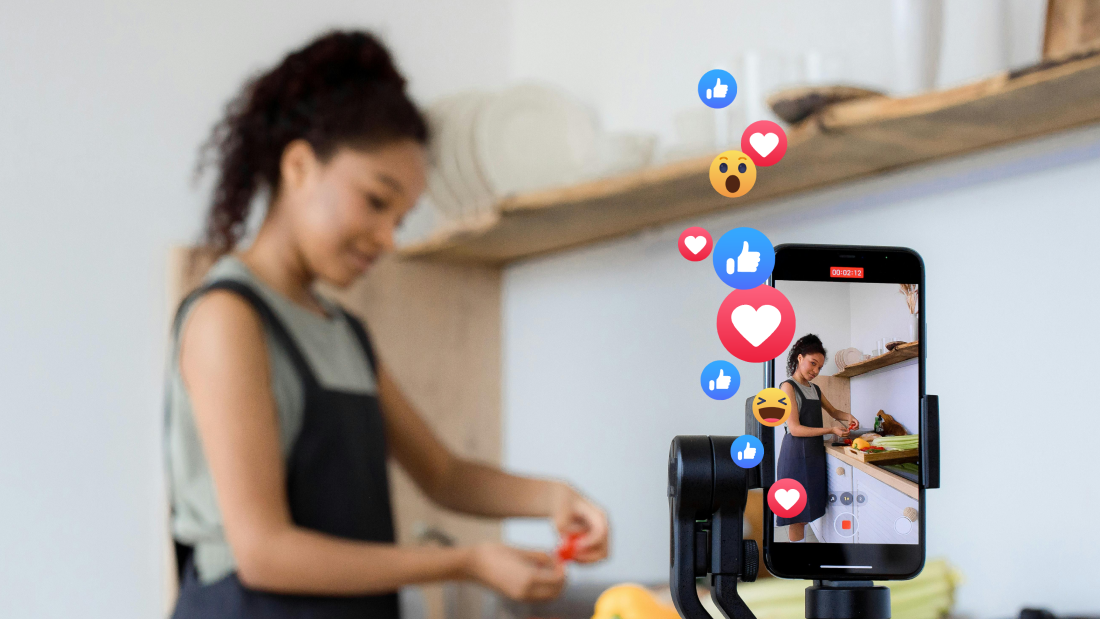
Being a good conversationalist is all about knowing a) whether the information you’re relaying is interesting and b) whether the person you’re talking to cares. Surely you’ve had the experience of being stuck in a conversation with a bad conversationalist, someone intent on relaying the minutiae of their obscure hobby despite your obvious lack of interest. If you’re like me, you nod politely while also sidling away from the talker slowly.

Truly skilled conversationalists, those adept at keeping the attention of another person, have a trick: talk primarily about the other person. Ask questions, show interest, remember what they said, and ask more related questions. This builds rapport, puts the other person at ease, and most critically, makes the other person feel important.
Good marketers and live video content creators do the same thing. To hold the attention of your audience, you must talk about your audience, even while you’re also relaying information about your business. And to talk about your audience, you must know who they are. This is why the second step of crafting your live video content strategy is all about identifying your business’s audience and then building personas to help you better understand them.
Understanding your live video audience through market research
Chances are, you already have some understanding of the audience for your business or organization, but it may be based on hunches. If you sell a product or service, who buys it and why? If you provide information or news, who seeks it out and why? If you’re a nonprofit, who donates or supports or engages and why?
Hunches can be a good frame of reference, but to validate (or invalidate) your hunches about who makes up your audience, you’re going to need to actually talk with your audience. This is market research at its most basic. There are many ways to conduct this research and many ways to gather audience member participants.
Audience samples
In my experience, your audience members will be more willing to talk than you anticipate. A simple phone call or email is a fine way to ask people to participate in your research. Just say you’re doing market research and want to understand their experiences and struggles and ask whether they’ll take your survey, attend your focus group, hop on a phone call, etc. You may try incentivizing participation with gift cards or giveaways. Sample audience members to talk to include:
- Longtime customers
- New customers
- Former customers
- Current leads
- Competitors’ customers
Info-gathering methods
You can go high-end or low-key with your info-gathering methods. I’ve tried everything from hosting luncheons for customers (will talk for food) to conducting extended one-on-one phone calls. The best method for you will be whichever one works with what you already have. If you’re in B2B and there’s an upcoming industry event that will get lots of people in one place, a focus group would be great. Or if you have lots of customer email addresses, emailed surveys are an easy, inexpensive way to go. Another option is to add an additional question or two to important forms on your website to gather more info about your customers. Common methods include:
- Focus groups
- Surveys
- One-on-one interviews or phone interviews
- Questions on forms
- Comment cards
Research questions
The questions you’ll ask will depend greatly on your industry. For instance, a company that creates accounting software will ask very different questions (“What’s the biggest timesuck in your day-to-day as an accountant?”) than a company that offers guided hikes (“What are your go-to outdoor activities?”), so it’s impossible to get a definitive list. There are, however, some key points you’ll likely want to hit:
- Age, gender, location, socioeconomic status, level of education, family makeup (demographics)
- What their day-to-day looks like
- What their main values, interests, and time commitments in life are
- Challenges or needs that would make your offering relevant
- What stresses, frustrates, or scares them related to the problem your offering solves
- How they learned about your offering
- What they'd like to know more about related to your offering or expertise
- Why they considered/chose/didn’t choose your offering among others
- What the main draws of your competitors are compared to you
- What their goals are, what success would look like to them related to your offering
- Where they get news and entertainment
Though the number of potential questions is limitless, you will have succeeded if you gather info both about what makes your audience members tick and about their goals, challenges, needs, and fears.
Building personas of your live video audience
 Once you’ve conducted your research and reviewed your findings (survey results, focus group notes, etc.), you should have a much more fleshed-out understanding of your business’s audience and, therefore, the audience for your live videos.
Once you’ve conducted your research and reviewed your findings (survey results, focus group notes, etc.), you should have a much more fleshed-out understanding of your business’s audience and, therefore, the audience for your live videos.
Of course, there’s a great likelihood that your audience will include many different types of people. Take the company offering guided hikes, for instance. Let’s say they’re based in the Pacific Northwest. Their offerings may appeal to teachers seeking educational field trips, retired folks looking for a little exercise and adventure, Instagrammers looking for cool photos, or any number of other people. This is where personas become especially helpful.
Personas are basically fictional people who represent a chunk of your audience, reflecting their demographic and psychographic information, their needs and experiences, and their buyer’s journey. It’s easier to talk to Sam, the elementary school teacher; Julie, the retiree; and Dave, the Instagrammer, than it is to talk to a vague audience made of dozens or hundreds of such people and more.
If your audience, like the hiking company's, has many types of people within it, try to separate people into a few categories and build one persona for each category. It helps to give your persona a name, an age, a job, and a story. For instance:
- Sam, age 29, is a 5th-grade teacher in Portland, Oregon. She finished her master’s in education two years ago, and this is her 7th year teaching. She loves her students but hates that they spend all day cooped up inside. Additionally, she needs an opportunity to get to know her students’ parents, and field trips sometimes provide that occasion. Sam herself is not that outdoorsy — she likes the idea better than the reality of it. She’s a member of a few Facebook groups for teachers in Oregon, where she gets a lot of information about opportunities for herself and her students.
- Julie, age 70, is a recently retired lawyer in Spokane, Washington, a mother of three and grandmother of one so far. She is highly active and walks every morning with her neighbor. She’s trying to get her husband into some form of exercise, but he is still working and struggles to make time for it. She’s determined for them to stay healthy for their kids and each other since her own parents did not take very good care of themselves. She is a member of the YMCA a few minutes away, and that’s her source of both news and socializing. She also uses Facebook and Instagram to keep up with her kids.
Most likely, each persona will tend to progress through your funnel in slightly different ways. Your younger personas, for instance, may progress slower because they have less disposable income. Or perhaps your older personas will progress slower because they're more hesitant to make purchases online. The buyer's journey will be different for every company and every persona, but it's important that you map out the typical purchase path for each persona based on the findings from your market research.
If you're creating your live video content strategy as you follow this blog series, you should already have a document in which you wrote your live video content goals. Below that section, in a new section titled Audience, summarize your findings about your audience — their demographics, their challenges, their interests, their purchase paths. Include the paragraphs you wrote about each persona. If you have enough data to estimate what percentage of your audience each persona represents, include that data as well.
Addressing your live video audience’s questions and pain points
Your personas will be at the forefront of your content planning as you build the rest of your live video content strategy. It’s their questions you’ll answer, their problems you’ll address, and, in a way, their stories you’ll tell in your videos. This is how you will keep their interest (like the good conversationalist you are) and how you will ensure you help them through your content while also guiding them through the buyer's journey.
Identifying your niche and brainstorming topic and video ideas will be the next two steps in creating your strategy. Subscribe to the blog to ensure you get these future posts and follow us on Facebook to watch our own weekly live video show, #StreamSquad. If there are more topics you’d like us to cover, please let us know in the comments.
Subscribe to the blog
Sign up to receive notifications whenever a new blog post is published. You may unsubscribe at any time.

Share
About the Author

As Switcher's content strategy manager, Kate strives to answer the questions of new and expert livestreamers alike. She has spent her career in digital marketing and content strategy and now funnels that experience into helping others plan and create their own video content.
All posts by Kate Brannen Smith

